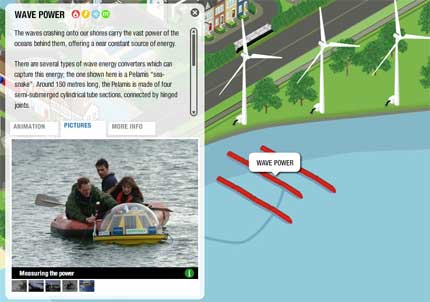
A screengrab from our virtual, climate-friendly town, EfficienCity
With the UK government apparently bending over backwards to stop renewable energy development at the moment, it's refreshing to hear some good news from elsewhere in Europe; the world's first commercial wave power farm has gone live in Portugal.
I spent a fair bit of time researching the Pelamis sea snakes which Portugal is using while I was working on EfficienCity, so I thought I'd revive (temporarily at least) The Weekly Geek column – now reincarnated as The (Not Very) Weekly Geek, for obvious reasons.
First off, a bit of history.
Once upon a time, there was war in the Middle East, oil prices were soaring, people were panicking about energy supply, the dollar was depreciating and share prices were tumbling.
I'm talking about 1973 and the oil crisis, but I'll leave it up to you to draw your own parallels with today's situation (remind me, are we in the tragedy or the farce stage now?).
With the embargo of oil to the US, Japan and much of Europe and the fixing of oil prices after the Yom Kippur War, oil prices quadrupled to $12 a barrel in a few months (yes, $12...). A recession hit many oil importers. Brazil turned to ethanol to fuel its cars. Japan moved its economy away from oil-intensive industries towards areas like electronics. And the UK began to take a serious interest in renewable energy sources.
Wave power, especially, was seen as bit of a holy grail. Our mid-latitude islands benefit from prevailing westerly winds that carry the power of the Atlantic behind them, and these winds blow strongest in the winter, when our demand for electricity is at its highest. Perfect, if we could only harness the waves' energy on a commercial scale. And, but for a decimal point, we might now have been doing exactly that.
I'll explain. In 1974, the UK government started a major wave energy research and development programme. Prototypes were made and tested. Teething problems led to modifications, improvements and, some say, over-engineering, which pushed up the cost of the electricity.
But, during a government evaluation of the cost of wave power, somebody 'accidentally' moved a decimal point, making wave power 10 times more expensive than it actually was. By the time the mistake was discovered years later, the research had been first scaled down and then abandoned by the government.
(If you’re interested in the secret history of wave power, have a scroll through this testimony from wave power pioneer David Salter, from about halfway down. He explains that the UK’s wave power programme was shut down after a closed meeting of a government committee, whose members were recruited from the nuclear and fossil fuel industries. The head of the UK wave power programme wasn’t allowed to attend the meeting. Officials favouring Big Energy over renewables? Plus ça change. But I digress.)
In recent years, there's been an, um, resurgence in wave power, largely thanks to pioneering companies and researchers. The world's first commercial wave power generator was developed on Islay in Scotland, using the Limpet machine (animation). The Orkney Isles have a hugely important test centre for wave and tidal machines. And there are commercial wave farms planned, including a scheme on Lewis. The Aguçadoura Wave Park in Portugal, of course, went live this week. And what will become the world's largest wave power array, the Wavehub, will be sited off the coast of Cornwall.
So how does wave power work?
You could consider the world’s oceans to be an enormous system for gathering energy from the sun and efficiently distributing it across time and space.
Wind is created, ultimately, by the sun’s heat; as the Earth’s surface is unevenly heated, areas of different pressure form, creating wind. When wind blows across the sea, some of the wind’s energy is transferred into the sea, in the form of waves. The waves can still carry this energy long after the wind has died down, and their journeys across the planet tend to be more predictable than those of the wind.
How much energy is transferred to the wave depends on how strong the wind is, how long it blows for and the size of the fetch (the distance of open water before land is reached). All of these factors – along with the depth and topography of the sea floor – help to determine the size of the wave.
The wave power is determined by the height, speed and wavelength of the wave, and water density.
Wave energy converters work by harnessing some of the wave's kinetic energy and converting it into mechanical and then electrical energy.
There are several types of wave energy converters around, but I'm going to stick to talking about the Pelamis - partly because it's the technology being used in Portugal and partly because I like the fact it's named after a sea snake (and it's my column).
The Pelamis harnesses energy from a combination of both wave size and wave power: the oscillatory motion of the sea - that is, the height from the wave's trough to crest, the wavelength (distance between crests) and the time interval between waves:
The Pelamis resembles the sea snake it's named after, except it's about 3.5 metres wide and 150 metres long. It's made of four floating (well, semi-submerged) cylindrical tube sections, connected by hinged joints. It's held in place by an anchor on the sea bed - a system of weights and measures make sure the mooring line stays slack, allowing the Pelamis to swing head on to oncoming waves. This is important: it allows the Pelamis to span several wave crests at the same time.
As waves roll into shore, the sections of tubing roll up and down and from side to side. The relative movement of the sections causes the joints between them to move and be compressed. This compression causes the hydraulic pump or "hydraulic ram" inside each joint to pump oil through a hydraulic motor at pressure. The motor drives an electrical generator, which produces electricity, which is carried to shore (typically five to ten kilometres away) via a sub-sea cable. There's plenty more information on Pelamis Wave Power's website.
The opportunities for wave power in the UK are there for the taking; according to government and industry figures, wave and tidal power combined could meet 12.5 per cent of today's electricity demand in the UK - economically and practically - by 2025. 2025, by the way, is the earliest anticipated date that we could see up to eight of the new nuclear reactors the government wants providing up to three per cent of our electricity.
But British businesses won't take the lead in renewables while business secretary John Hutton is undermining them in favour of old, inefficient technologies like coal and nuclear power. As far as wave power goes, we don't have time to let history to repeat itself a third time.
Previously, in the Weekly Geek:


